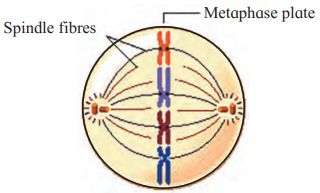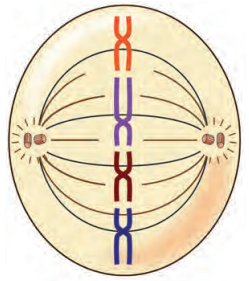Cell Division – Solutions
1. Choose correct option
A. The connecting link between Meiosis – I and Meiosis – II is …………
(a) interphase – I
(b) interphase – II
(c) interkinesis – III
(d) anaphase – IV
Answer: (c) interkinesis – III
B. Synapsis is pairing of ………………. .
(a) any two chromosomes
(b) non – homologous chromosomes
(c) sister chromatids
(d) homologous chromosomes
Answer: (d) homologous chromosomes
C. Spindle apparatus is formed during which stage of mitosis?
(a) Prophase
(b) Metaphase
(c) Anaphase
(d) Telophase
Answer: (b) S-phase
D. Chromosome number of a cell is almost doubled up during _______ .
(a) G1 – phase
(b) S – phase
(c) G2-phase
(d) G0-phase
Answer: (b) S – phase
E. How many meiotic divisions are necessary for formation of 80 sperms?
(a) 80
(b) 40
(c) 20
(d) 10
Answer: (c) 20
F. How many chromatids are present in anaphase – I of meiosis – I of a diploid cell having 20 chromosomes?
(a) 4
(b) 6
(c) 20
(d) 40
Answer: (d) 40
G. In which of the following phase of mitosis chromosomes are arranged at equatorial plane?
(a) Prophase
(b) Metaphase
(c) Anaphase
(d) Telophase
Answer: (b) Metaphase
H. Find incorrect statement.
(a) Condensation of chromatin material occurs in prophase.
(b) Daughter chromatids are formed in anaphase.
(c) Daughter nuclei are formed at metaphase.
(d) Nuclear membrane reappears in telophase.
Answer: (c) Daughter nuclei are formed at metaphase.
I. Histone proteins are synthesized during
(a) G1 phase
(b) S – phase
(c) G2 – phase
(d) Interphase
Answer: (b) S – phase
2. Answer the following questions
A. While observing a slide, student observed many cells with nuclei. But some of the nuclei were bigger as compared to others but their nuclear membrane was not so clear. Teacher inferred it as one of the phase in the cell division. Which phase may be inferred by teacher?
Answer: The teacher likely inferred prophase of mitosis. During prophase, the nucleus enlarges, chromosomes condense, and the nuclear membrane begins to break down, making it less distinct, which matches the student’s observation.
B. Students prepared a slide of onion root tip. There were many cells seen under microscope. There was a cell with two groups of chromosomes at opposite ends of the cell. This cell is in which phase of mitosis?
Answer: The cell is in the anaphase of mitosis. In anaphase, sister chromatids are pulled apart by spindle fibers, forming two distinct groups of chromosomes at opposite poles of the cell.
C. Students were shown some slides of cancerous cells. Teacher made a comment as if there would have been a control at one of its cell cycle phase, there wouldn’t have been a condition like this. Which phase the teacher was referring to?
Answer: The teacher was referring to the G1 phase (or the G1/S checkpoint) of the cell cycle. This phase includes a checkpoint that regulates cell division by ensuring DNA integrity and proper conditions for replication, preventing uncontrolled division seen in cancer.
D. Some Mendelian hybridization experimental results were shown to the students. Teacher informed that there are two genes located on the same chromosome. He enquired if they will be ever separated from each other?
Answer: Yes, the two genes can be separated through crossing over during prophase I of meiosis. Genes on the same chromosome (linked genes) may exchange segments between homologous chromosomes, leading to recombination, with the likelihood depending on the distance between them.
E. Students were observing a film on Paramoecium. It underwent a process of reproduction. Teacher said it is due to cell division. But students objected and said that there was no disappearance of nuclear membrane and no spindle formation, how can it be cell division? Can you clarify?
Answer: The reproduction in Paramecium observed is likely binary fission, a type of asexual cell division in unicellular organisms. Unlike mitosis, binary fission does not involve nuclear membrane disappearance or spindle formation; the nucleus divides by amitosis, and the cell splits into two identical daughter cells. This process is still considered cell division as it results in two cells from one.
F. Is the meiosis responsible for evolution? Justify your answer.
Answer: Yes, meiosis is responsible for evolution. It generates genetic diversity through crossing over (recombination) in prophase I and random assortment of chromosomes in metaphase I, producing varied gametes. This genetic variation provides raw material for natural selection, driving evolutionary changes.
G. Why mitosis and meiosis-II are called as homotypic division?
Answer: Mitosis and meiosis-II are called homotypic divisions because they involve the separation of sister chromatids, resulting in daughter cells with identical genetic content (same chromosome number and gene copies). In mitosis, this occurs to produce two identical somatic cells, while in meiosis-II, it separates chromatids in haploid cells, maintaining genetic similarity within each division. Unlike meiosis-I (heterotypic), which reduces chromosome number, these divisions preserve ploidy.
H. Write the significance of mitosis.
Answer: Mitosis ensures growth, repair, and maintenance of multicellular organisms by producing two identical daughter cells with the same chromosome number as the parent. It enables tissue regeneration, wound healing, and asexual reproduction in some organisms. Additionally, it maintains genetic stability by ensuring accurate chromosome distribution.
I. Enlist the different stages of prophase-I.
Answer: The stages of prophase-I in meiosis are:
- Leptotene: Chromosomes begin to condense, appearing thread-like.
- Zygotene: Homologous chromosomes pair up (synapsis), forming bivalents.
- Pachytene: Crossing over occurs, exchanging genetic material between homologous chromosomes.
- Diplotene: Homologous chromosomes begin to separate, but remain attached at chiasmata.
- Diakinesis: Chromosomes fully condense, chiasmata resolve, and the nuclear membrane breaks down.
3. Draw labelled digrams and write explanation –
A. With the help of suitable diagram, describe the cell cycle.
Answer:
1. Series of events occurring in the life of a cell is called cell cycle. Interphase and M – phase are the two phases of cell cycle.
2. Interphase: It is the stage between two successive cell divisions. It is the longest phase of a cell cycle during which the cell is highly active and prepares itself for cell division.
The interphase is subdivided into three sub-phases as G1 – phase, S-phase and G2-phase.
a. G1 – phase (First gap period/First Gap Phase):
It begins immediately after cell division.
RNA (mRNA, rRNA and tRNA) synthesis, protein synthesis and synthesis of membranes take place during this phase.
b. S – phase (Synthesis phase):
In this phase DNA is synthesized (replicated), so that amount of DNA per cell doubles.
Synthesis of histone proteins takes place in this phase.
c. G2 – phase (Second growth phase/Second Gap Phase):
Metabolic activities essential for cell division occur during this phase.
Various proteins which are necessary for the cell division are also synthesized in this phase.
Apart from this, RNA synthesis also occurs during this phase.
In animal cells, a daughter pair of centrioles appears near the pre-existing pair.
B. Distinguish between mitosis and meiosis.
Answer:
| Mitosis | Meiosis |
| (a) It occurs in somatic cells and stem cells. | It occurs in germ cells. |
| (b) In this nucleus divides only once. | In this nucleus divides twice (Meiosis I and Meiosis II) |
| (c) In these two daughter cells are formed. | In these four daughter cells are formed. |
| (d) Daughter cells formed by mitotic division are diploid (2n). | Daughter cells formed by meiotic division are haploid (n)• |
| (e) In mitosis, crossing over does not take place. | In meiosis, crossing over takes place. |
| (f) Mitosis plays an important role in growth, repair, healing and development. | Meiosis is important for formation of haploid gametes and spores. |
C. Draw the diagram of metaphase.
Answer:
4. Match the following column-A with column-B and rewrite.
| Column I (Phases) | Column II (Their events) |
| 1. Leptotene | (a) Crossing over |
| 2. Zygotene | (b) Desynapsis |
| 3. Pachytene | (c) Synapsis |
| 4. Diplotene | (d) Bouquet stage |
Answer:
| Column I (Phases) | Column II (Their events) |
| 1. Leptotene | (d) Bouquet stage |
| 2. Zygotene | (c) Synapsis |
| 3. Pachytene | (a) Crossing over |
| 4. Diplotene | (b) Desynapsis |
5. Is a given figure correct? why?
Answer:
1. The given figure is incorrect as the spindle fibres are not attached to centromere of the chromosomes.
2. During metaphase, chromosomes are attached to spindle fibres with the help of centromeres.
6. If an onion has 16 chromosomes in its leaf cell, how many chromosomes will be there in its root cell and pollen grain.
Answer:
- Root cell: The root cell, like the leaf cell, is a somatic (body) cell and will have the same diploid number of chromosomes. Since the leaf cell has 16 chromosomes (2n = 16), the root cell will also have 16 chromosomes.
- Pollen grain: Pollen grains are haploid male gametes produced by meiosis in the anther. Meiosis reduces the chromosome number by half, so if the diploid number is 16 (2n = 16), the haploid number is 8 (n = 8). Therefore, the pollen grain will have 8 chromosomes.
7. Identify the following phases of mitosis and label the ‘A’ and ‘B’ given in diagrams
Answer: The diagram shown is of Metaphase.
A: Chromosomes arranged on metaphase plate
Answer:
The diagram shown is of Anaphase.
B: Chromatids moving to opposite poles.






Leave a Reply